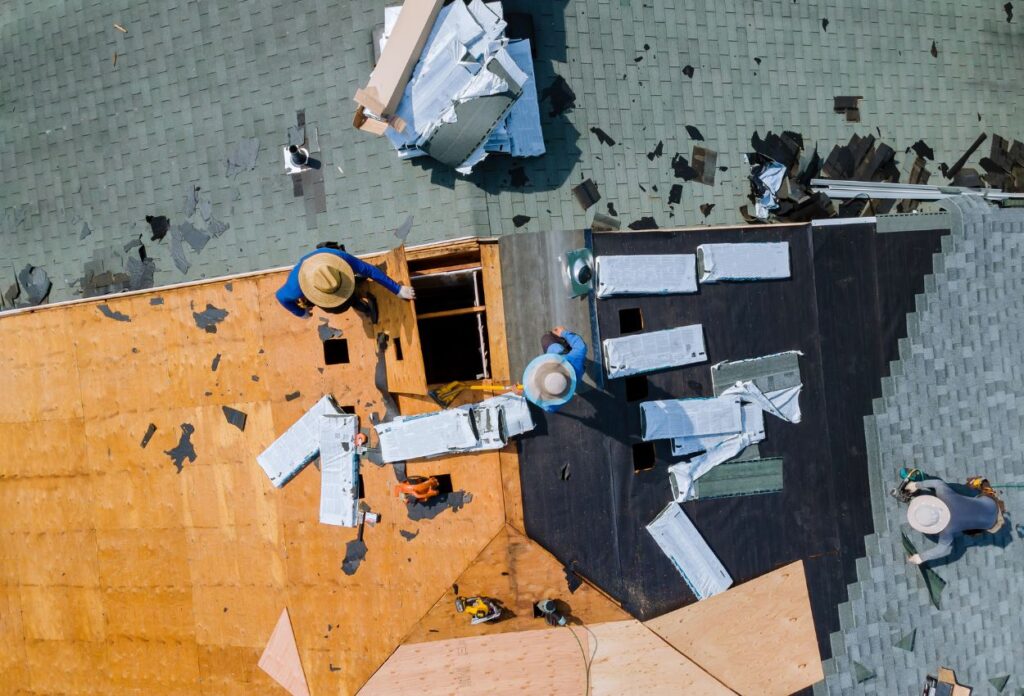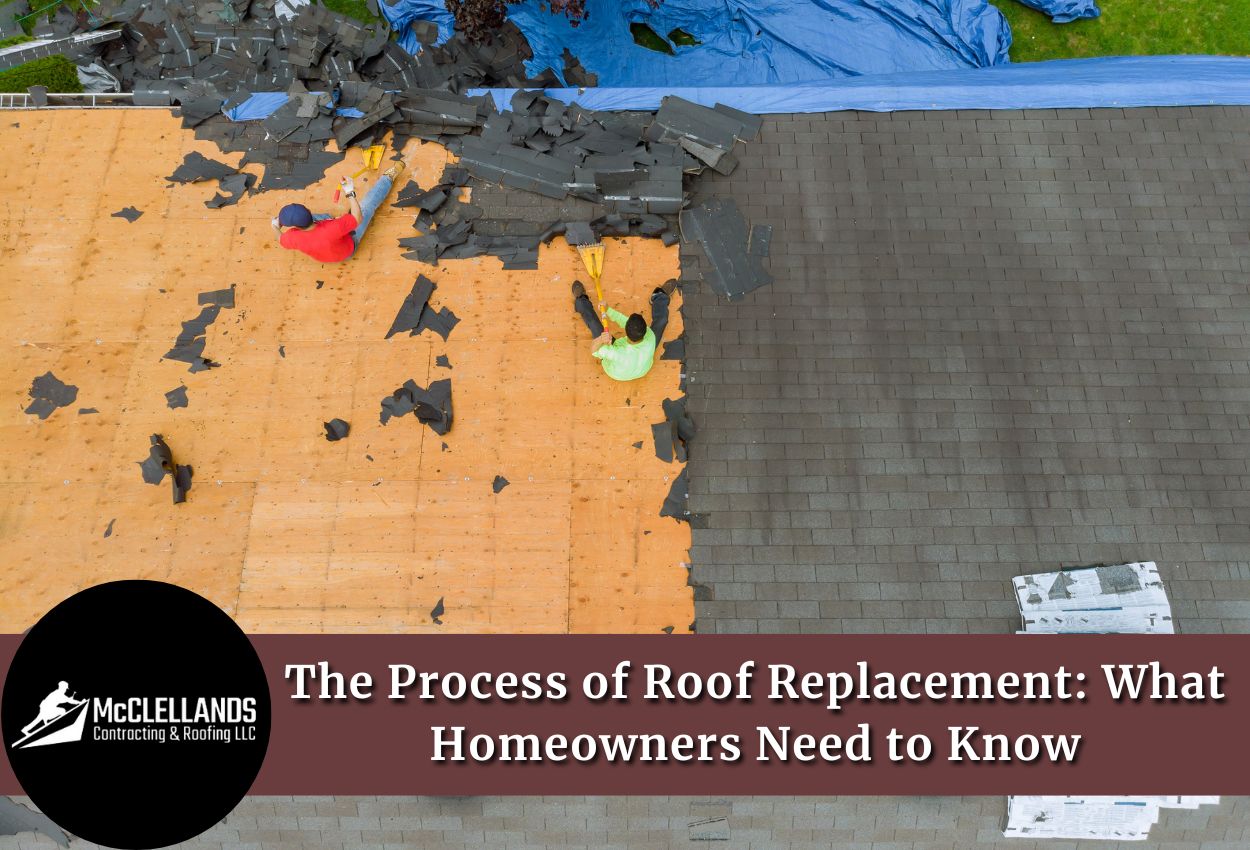When thinking about replacing your roof, there are a few things you need to keep in mind. From timing the project to choosing materials, there are many steps in the roof replacement process.
At McClellands Contracting and Roofing, LLC, we are your local roofing company, and we understand the importance of a quality roof replacement. In this complete blog post, we will discuss everything you should know about the process of roof replacement.
If you are looking for a no-obligation discussion about your roof’s health, call us today at (412) 353-5660 for a free roof inspection.
What Is The Process To Replace A Roof?

Starting with today’s topic, the process of roof replacement includes some important steps. Understanding this process will help you make informed decisions about your roof replacement project and ensure you’re well-prepared when the time comes.
Materials Required
Before starting the roof replacement process, you should have the right tools and materials. Here is a list of all the materials and tools to have before starting the process of roof replacement:
🔨 Roofing shovel or tear-off shovel
🔨 Hammer and pry bar
🔨 Roofing nail gun and compressor
🔨 Safety equipment (harnesses, non-slip boots, safety glasses)
🔨 Extension ladders
🔨 Cutting tools (utility knife, tin snips)
🔨 Measuring tape and chalk line
🔨 Magnetic sweep for nail cleanup
🔨 Roofing material (asphalt shingles, metal, or your chosen material)
🔨 Underlayment (synthetic or felt paper)
🔨 Ice and water shield (if needed)
🔨 Drip edge and flashing
🔨 Ridge caps and vents
🔨 Roofing nails
🔨 Roofing cement
🔨 Starter shingles (if needed)
🔨 Pipe boot flashing
The Process Of Replacing a Roof: Step-By-Step Guide
Here we will walk you through the complete roof replacement process. Each step is very important for ensuring your new roof protects your home for years to come.
#1 Roof Inspection and Preparation
Before starting with the actual roof replacement process, your roofing contractor will perform a thorough inspection of your existing roof structure. During this inspection, they’ll check for any underlying structural problems that may need attention.
They’ll also protect your property by covering your landscaping, moving outdoor furniture, and ensuring clear access to your roof.
Your contractor will also arrange for a dumpster to be delivered for disposal of the old roofing materials.
#2 Removing the Old Roofing Materials
The first major step in replacing your roof is removing all the existing shingles, underlayment, and flashing. Your roofing team will start from the top of your roof and work their way down, carefully removing all old materials. They’ll use tools like roofing shovels and pry bars to remove the old shingles efficiently.
#3 Assessing and Repairing the Roof Deck
Once your old roof is completely removed, your contractors will carefully examine your roof’s decking.
This wooden layer serves as the foundation for your new roof, so it needs to be in perfect condition. If they find any soft spots, water damage, or rotting wood, they’ll replace those sections with new plywood or boards.
Making these repairs now is crucial because problems with your decking can lead to serious issues later.
#4 Installing the Drip Edge and Ice & Water Shield
After ensuring your roof deck is sound, the next step is installing the drip edge along your roof’s eaves. This metal flashing helps direct water into your gutters, protecting your fascia boards from any further water damage.
Then, your roofers will install an ice and water shield, which is really helpful and important in Pittsburgh’s climate. This waterproof barrier helps prevent damage caused by ice dams and water backup during our snowy winters.
#5 Laying Down the Underlayment
The next important step is installing a high-quality underlayment across your entire roof. This layer works as a secondary barrier against water infiltration.
Your roofers will carefully roll out the underlayment, making sure it’s properly overlapped and secured. This step is very important in our area because of the frequent rain and snow we experience throughout the year.
#6 Installing New Flashing
Proper flashing installation is important for preventing leaks around your roof’s most vulnerable areas.
Your roofers will install new flashing around your chimney, vents, and skylights and in your roof’s valleys.
They’ll carefully seal these vulnerable areas with appropriate roofing cement to make sure they remain watertight for years to come.
#7 Installing the New Shingles
Now comes the main step, which is installing your new shingles. Your roofers will start at the bottom edge of your roof and work their way up, carefully overlapping each row.
They’ll use starter shingles along the edges for extra protection against wind uplift.
Each shingle will be properly aligned and secured with the correct number of nails, placed in exactly the right spots for maximum wind resistance.
#8 Adding Ridge Vents and Caps
The final step in the installation process is adding ridge vents (if your roof design calls for them) and ridge caps.
Ridge vents help maintain proper attic ventilation, which is crucial for extending your roof’s lifespan and maintaining your home’s energy efficiency.
The ridge caps not only provide a finished look but also protect the highest points of your roof from water infiltration.
How Long Does It Take to Replace a Roof?
The timeline for your roof replacement project depends on certain things, including your roof’s size, complexity, and weather conditions.
For most homes in Pittsburgh and nearby areas, a complete roof replacement generally takes between one and three days. However, larger homes or more complex roof designs might require four to five days for completion.
Again, weather plays an important role in calculating the timeline, especially in our region’s fluctuating climate.
Your roofing contractors will carefully plan the project around weather forecasts to make sure that the work can be completed safely and effectively. They might need to adjust the schedule if there’s a chance of rain, snow, or severe storms.
The condition of your existing roofing system can also affect the total timeline. If your contractors spot any major damage to your roof deck during the old roof removal process, these necessary repairs will add more time to the project.
However, addressing these issues properly is crucial for the longevity of your new roof.
What Are Common Signs A Roof Needs To Be Replaced?
Understanding common signs that a roof replacement is needed can help you avoid emergency situations and allow you to budget for this significant home improvement project. Here are a few signs that suggest it’s time for a new roof:
#1 Age Of Your Roof
A normal asphalt shingle roof lasts about 20 to 25 years before needing replacement.
Local weather conditions play an equally important role here, as in areas with frequent rain, snow, and temperature changes, your roof can age faster.
Even if your roof looks fine on the surface, once it has completed its lifespan, it is wiser to plan for a new one.
#2 Visible Shingle Damage
Check for shingles that curl up at the edges or start buckling. Missing shingles, cracks, and bare spots are clear red flags.
Also, when you notice dark patches or find granules collecting in your gutters, it means the protective layer of your shingles is wearing away, which can leave your roof vulnerable to damage.
#3 Water Damage
Another thing we recommend is to check your attic regularly for warning signs. If you see daylight through the roof boards, spot wet areas on the wood, or notice your roof is sagging, you have serious problems.
Water stains on interior ceilings and damp attic insulation mean your roof is letting moisture in.
#4 Rise In Energy Costs
When your heating and cooling bills suddenly increase, your roof might be the culprit. Old or damaged roofing materials often fail to insulate properly.
Poor ventilation through the roof system can make your HVAC system work harder, which can result in higher energy bills.
#5 Storm Impact
Severe weather can speed up roof deterioration. Check for dents from hail, shingles lifted by strong winds, and damage from fallen branches.
In cold climates, ice dams can form at roof edges during winter, forcing water under shingles and causing leaks and structural damage.
How Much Does It Cost To Replace A Roof?
When planning your roof replacement, understanding the costs involved helps you make better financial decisions.
The exact and final cost of your roof replacement depends on multiple factors. This includes the size of your roof, the material you choose, the complexity of your roof’s design, and the labor costs of your local area.
Generally, you can expect anywhere from $5,700 to $ 12,300 to replace a roof. However, in Pittsburgh and surrounding Pennsylvania areas, you might see costs between $8,000 and $15,000 because of our specific climate requirements and local building codes.
These prices reflect the need for high-quality materials that can withstand our region’s snow, rain, and temperature variations.
**Please note that the price ranges listed in this article may not reflect the final cost of your project. Prices are subject to change based on various factors such as local labor rates, material quality, and more. All costs established in this article are rough estimates based on average industry rates.**
Also Read: When Is The Best Time To Replace A Roof?
How Long Does A Roof Last?
Understanding your roof’s lifespan helps you plan for future replacement and maintain your current roof properly. Different roofing materials have varying lifespans, and your roof’s longevity also depends on our local climate conditions in Pittsburgh.
Asphalt Shingle Roofs
The most common roofing material in our area, asphalt shingles generally last a few decades.
👉 3-Tab shingles: 15 to 20 years
👉 Architectural shingles: 20 to 30 years
👉 Luxury shingles: 25 to 35 years
However, Pittsburgh’s harsh winters and summer storms can impact these timeframes. Regular maintenance and installation by experienced professionals help maximize your roof’s lifespan.
Other Roofing Materials
👉 Metal roofs: 40 to 70 years
👉 Slate roofs: 75 to 100 years
👉 Wood shakes: 20 to 25 years
👉 Clay tiles: 50 to 100 years
Can You Replace A Roof Yourself?
While it’s technically possible to replace a roof by yourself, it’s generally not recommended because of safety and technical reasons.
Professional roofers have the required safety equipment, training, and experience working at heights, along with team support for dangerous tasks and insurance coverage in case of accidents.
They also possess important technical expertise, including knowledge of local building codes, proper installation techniques, ventilation requirements, and water barrier systems.
Most importantly, DIY roof installation or replacement generally voids manufacturer warranties, whereas professional installation comes with material warranties, workmanship guarantees, and proper documentation for future claim protection.
Though tackling the project yourself may initially look like a cost-saving option, the risks and complexity of roof replacement make it a job best left to qualified professionals.
Also Read: What Are The Pros And Cons Of DIY Roof Repair?
Professional Roof Replacement Services In Pennsylvania
At McClellands Contracting and Roofing, LLC, we are your trusted roofing company in Pittsburgh and the surrounding areas of Pennsylvania.
We understand that your roof plays a critical role in your home’s overall functionality and appearance. We only use high-quality materials and follow the right steps to make sure that your roof not only looks good but protects your property for many years to come.
Our local experience means we know exactly what your roof needs to perform effectively in Pittsburgh’s climate. Call us today at (412) 353-5660 for a free, no-obligation roof inspection and consultation.
FAQs
A. Yes! There’s a lot of technical stuff involved, including building codes, proper installation methods, and understanding ventilation. It’s not just about nailing down shingles!
A. Bad news – most manufacturers will void your warranty if you install it yourself. When pros do it, you get additional perks like material warranties and workmanship guarantees.

